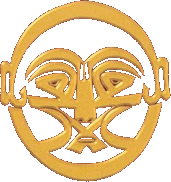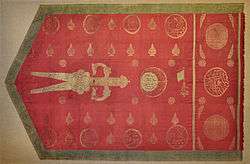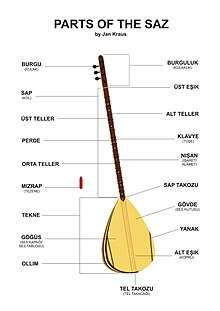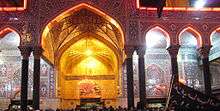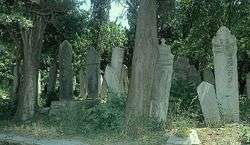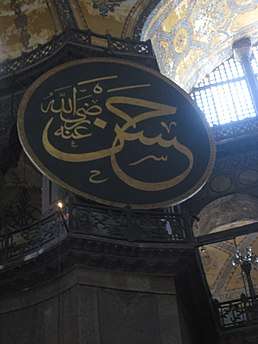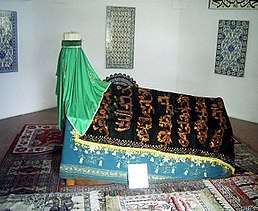Alevism
Alevism (/æˈlɛvɪzəm/; Turkish: Alevilik, Anadolu Aleviliği or Qizilbash,[1] Kurdish: Elewîtî[2]) is a syncretic,[3] heterodox,[4] and local Islamic tradition,[5] whose adherents follow the mystical (bāṭenī)[6] teachings of Ali, the Twelve Imams and a descendant—the 13th century Alevi saint Haji Bektash Veli. Alevis are found primarily in Turkey among ethnic Turks and Kurds,[7] and make up approximately 11% of the population;[8] they are the second-largest sect of Islam in Turkey, with Sunni Hanafi Islam being the largest.[5]
| Alevism | |
|---|---|
.jpg) Hacı Bektaş-i Veli | |
| Scripture | Quran, Nahj al-Balagha, Makalat and Buyruks |
| Leader | Dede |
| Teachings of | Imam Ali, Imam Ja'far al-Sadiq, Khoja Akhmet Yassawi, Qutb ad-Dīn Haydar, Barack Baba, Sarı Saltık, Yunus Emre, Abdal Musa, Kaygusuz Abdal, Nesîmî, Gül Baba, Kul Nesîmî, Pir Sultan |
| Theology | Haqq-Muhammad-Ali |
| Region | Turkey |
| Language | Turkish language |
| Liturgy | Jem, Samāh |
| Headquarters | Hacıbektaş complex, Nevşehir, Turkey |
| Founder | Haji Bektash Veli |
| Origin | 13th century Sulucakarahöyük |
| Separated from | Sunni and Shī‘ah theology |
| Absorbed | Babais |
| Other name(s) | Kızılbaşlık |
After the death of the Islamic prophet Muhammad, a dispute arose about his legitimate successor. The Islamic community was divided into those who adhered to Abu Bakr, named Sunnis, and those who sided with Ali, called Shia. Concurrently, people who sided with Ali were called Alevis, defined as "those who adore Ali and his family".[9] Therefore, some authors use Shiism synonymously with Alevism.[10] However, Alevism is not Twelver Shiism, but rather its own Sufi centric form of Shiism,[10] and although they share some common beliefs with the Twelver Shia, their rites and practises are different from Shiism.[9] Thus Alevism incorporates Turkish and Kurdish folk and cultural beliefs present during the 14th century,[9] mixed with Shia, Sunni and Sufi beliefs that were adopted by some Turkish and Kurdish tribes and later integrated into Sunni Islam.[10]
Alevis have strong links with Twelver Shia Islam (such as importance of the Ahl al-Bayt, the Aşura, the Mourning of Muharram, commemorating Karbala), but do not follow taqlid towards a Marja' "source of emulation". Some practices of the Alevis are based on Sufi elements of the Bektashi[4] Tariqa.[11][12]
Etymology
"Alevi" (/æˈlɛvi/) is generally explained as referring to Ali, the cousin and son-in-law of Muhammad. The name represents a Turkish form of the word ‘Alawi (Arabic: علوي) "of or pertaining to Ali".
A minority viewpoint is that of the Ishikists, who assert, "Alevi" was derived from "Alev" ("flame" in Turkish) in reference to fire which is extensively used in Alevi rituals. According to them the use of candles is based on Quran chapter 24, verses 35 and 36:
"God is the Light of the heavens and the earth. The example of His light is like a niche within which there is a lamp, the lamp is encased in a glass, the glass is like a radiant planet, which is lit from a blessed olive tree that is neither of the east nor of the west, its oil nearly gives off light even if not touched by fire. Light upon light, God guides to His light whom He pleases. And God sets forth examples for the people, and God is aware of all things. (Lit is such a Light) in houses, which God has permitted to be raised to honor; for the celebration, in them, of His name: In them is He glorified in the mornings and in the evenings, (again and again).")
Beliefs
According to scholar Soner Çağaptay, Alevism is a "relatively unstructured interpretation of Islam".[13] Journalist Patrick Kingsley states that for some self-described Alevi, their religion is "simply a cultural identity, rather than a form of worship".[5]
Many teachings are based on an orally transmitted tradition, traditionally kept secret from outsiders (but now widely accessible). Alevis commonly profess the Islamic shahada, but adding "Ali is the friend of God".
The basis for Alevis' most distinctive beliefs is found in the Buyruks (compiled writings and dialogues of Sheikh Safi-ad-din Ardabili, and other worthies). Also included are hymns (nefes) by figures such as Shah Ismail or Pir Sultan Abdal, stories of Hajji Bektash and other lore.
God
In Alevi cosmology, God is also called Al-Haqq (the Truth)[14] or referred to as Allah. God created life, so the created world can reflect His Being.[15]
Alevis believe in the unity of Allah, Muhammad, and Ali, but this is not a trinity composed of God and the historical figures of Muhammad and Ali. Rather, Muhammad and Ali are representations of Allah's light (and not of Allah himself), being neither independent from God, nor separate characteristics of Him.[14]
| Haqq-Muhammad-Ali | ||
|---|---|---|
| Muhammad-Ali | ALLAH | |
| ALI | MUHAMMAD | |
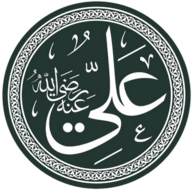 |
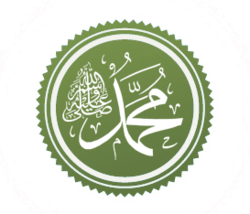 |
 |
| Left side: Ali ibn Abi Talib, Center: Muhammad, Right side: Allah. (Reflections of the Qizilbash-Bektashi belief) | ||
In Alevi writings are many references to the unity of Muhammad and Ali, such as:
Ali Muhammed'dir uh dur fah'ad, Muhammad Ali, (Ali is Muhammad, Muhammad is Ali) Gördüm bir elmadır, el-Hamdû'liLlâh. (I've seen an apple, all praise is for God)[16]
The phrase "For the love of Allah-Muhammad-Ali" (Hakk-Muhammed-Ali aşkına) is common to several Alevi prayers.
Spirits and afterlife
Alevis believe in the immortality of the soul.[14] Alevis, who believe in a literal existence of supernatural beings, also believe in good and bad angels (melekler), basically the same as within some Sunni Islam traditions and also believe in spirits (Cinler). Alevis, believe in Satan who is the one that encourages human's evil desires (nefs). Alevis, believe in a existence of spiritual creatures, such as the jinn and the evil eye.[17]
Scriptures and prophets
Like Orthodox Islam, all Alevis acknowledge at least the four scriptures revealed from heaven.[18] Additionally, Alevis don't mind to look to other religious books outside the four major ones as sources for their beliefs including Hadiths, Nahjul Balagha and Buyruks. Alevism also acknowledges the Islamic prophet Mohammed (peygamber).[19]
| "Alevi-Bektashis acknowledge they are from Ahl al Kitab" by stating that the last four holy books (Quran, Gospel, Torah and Psalms) has the same degree of importance in guiding people to the Divine Truth. This confession is pronounced in Turkish: "Dört kitab'ın Dördü de Hâkk". (Four valid books in Islam, namely Psalms, Torah, Gospel, and Qur'an are all the "Righteous") | |||
|---|---|---|---|
| Quran | Gospel | Torah | Psalms |
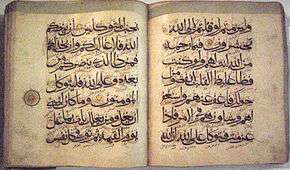 |
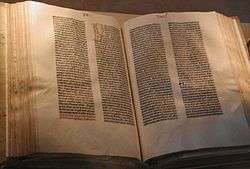 |
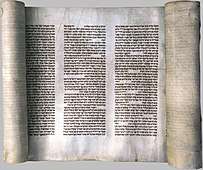 |
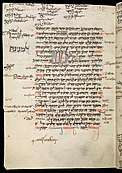 |
| Quran Surah 2 verse 136 says: "We believe in Allah, and in that which has been sent down on us and sent down on Abraham, Ishmael, Isaac and Jacob, and the Tribes, and that which was given to Moses and Jesus and the Prophets, of their Lord; we make no division between any of them, and to Him we surrender". | |||
The Twelve Imams
The Twelve Imams are part of another common Alevi belief. Each Imam represents a different aspect of the world. They are realized as twelve services or On İki Hizmet which are performed by members of the Alevi community. Each Imam is believed to be a reflection of Ali ibn Abu Talib, the first Imam of the Shi'ites, and there are references to the "First Ali" (Birinci Ali), Imam Hasan the "Second 'Ali" (İkinci Ali), and so on up to the "Twelfth 'Ali" (Onikinci Ali), Imam Mehdi. The Twelfth Imam is hidden and represents the Messianic Age.
Plurality
There are two sides to creation, one from a spiritual center to plurality, another from plurality to the spiritual center. Plurality is the separation of pure consciousness from the divine source. It is seen as a curtain alienating creation from the divine source and an illusion which called the Zāherī or exoteric side to reality. The hidden or true nature of creation is called the bāṭenī[6] or the esoteric.
The plurality in nature is attributed to the infinite potential energy of Kull-i Nafs when it takes corporeal form as it descends into being from Allah. During the Cem ceremony, the cantor or aşık sings:
- "All of us alive or lifeless are from one, this is ineffable, Sultan.
- For to love and to fall in love has been my fate from time immemorial."
This is sung as a reminder that the reason for creation is love, so that the followers may know themselves and each other and that they may love that which they know.
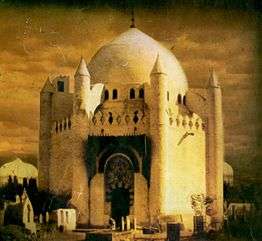
The Perfect human being
Linked to the concept of the Prototypical Human is that of the "Perfect Human Being" (Insan-i Kamil). Although it is common to refer to Ali and Haji Bektash Veli or the other Alevi saints as manifestations of the perfect human being, the Perfect Human Being is also identified with our true identity as pure consciousness, hence the Qur'anic concept of human beings not having original sin, consciousness being pure and perfect. The human task is to fully realize this state while still in material human form.
The perfect human being is also defined in practical terms, as one who is in full moral control of his or her hands, tongue and loins (eline diline beline sahip); treats all kinds of people equally (yetmiş iki millete aynı gözle bakar); and serves the interests of others. One who has achieved this kind of enlightenment is also called "eren" or "münevver" (mūnavvar).
Interpretation of tafsir
According to The President of the Islamic-Alevi Religious Services Dede İzzettin Doğan, "Alevism" is simply a tasawwufī-bāṭenī[6] interpretation (tafsir) of Islam.[20]
What's Alevism, what's the understanding of Islam in Alevism? The answers to these questions, instead of the opposite of what's known by many people is that the birthplace of Alevism was never in Anatolia. This is an example of great ignorance, that is, to tell that the Alevism was emerged in Anatolia. Searching the source of Alevism in Anatolia arises from unawareness. Because there was not even one single Muslim or Turk in Anatolia before a specific date. The roots of Alevism stem from Turkestan – Central Asia. Islam was brought to Anatolia by Turks in 10th and 11th centuries by a result of migration for a period of 100–150 years. Before this event took place, there were no Muslim and Turks in Anatolia. Anatolia was then entirely Christian.[21] We Turks brought Islam to Anatolia from Turkestan. —Professor İzzettin Doğan, The President of Alevi-Islam Religion Services
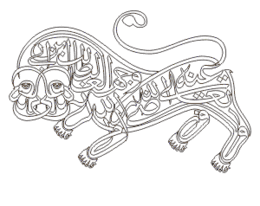
Alevi used to be grouped as Kızılbaş ("redheads"), a generic term used by Sunni Muslims in the Ottoman Empire for the various Shia sects from the 15th century. Many other names exist (often for subgroupings), among them Tahtacı "Woodcutters", Abdal "Bards" and Çepni.
Creed and jurisprudence
Sources differ on how important formal doctrine is among contemporary Alevi. According to scholar Russell Powell there is a tradition of informal "Dede" courts within the Alevi society, but regarding Islamic jurisprudence or fiqh there has been "little scholarship on Alevi influences" in it.[22]
Other sources put more emphasis on creed and doctrine. Alevīs follow Tasawwufī-Batiniyya aqidah (creed) of Maymūn’al-Qāddāhī according to one source (Dede İzzettin Doğan).[23][24] In contrast the Sunni majority of Turkey's population follows Maturidi aqidah of the Hanafi fiqh and Ash'ari aqidah of the Shafi'i fiqh. According to another source, Alevi aqidah (creed or theological convictions) is based upon a syncretic fiqh system called as Batiniyya-Sufism/Ismailism[25] which incorporates some sentiments of Sevener-Qarmatians, originally introduced by Abu’l-Khāttāb Muhammad ibn Abu Zaynab al-Asadī,[26][27] and later developed by "Maymun al-Qāddāh" and his son "ʿAbd Allāh ibn Maymun",[28] and Mu'tazila with a strong belief in the Twelve Imams.
- "The Alevi-Turks" has a unique belief system tracing back to Kaysanites and Khurramites which are considered Ghulat Shia Islam by some. According to Turkish scholar Abdülbaki Gölpinarli, the Qizilbash (Red-Heads) of the 16th century – a religious and political movement in Azerbaijan that helped to establish the Safavid dynasty – were spiritual descendants of the Khurramites.[29]
- Among the members of the "Qizilbash-Tariqa" who are considered as a sub-sect of the Alevis, two figures firstly Abu Muslim Khorasani , who assisted Abbasid Caliphate to beat the Umayyad Caliphate but later eliminated and murdered by Caliph Al-Mansur and secondly Babak Khorramdin who incited a rebellion against Abbasid Caliphate and consequently was killed by Caliph al-Mu'tasim, are highly respected. This belief provides strong clues about their Kaysanites Shia and Khurramites origins. In addition, Safaviyya Tariqa leader Shāh Ismāʿīl is a highly regarded individual in the belief of Alevi-Qizilbash-Tariqa associating them with the Imamah (Shia Twelver doctrine) conviction of Twelver Shia Islam.
- On the other hand, Bektashis has a conviction of Batiniyya Ismailism[25] and Hurufism with a strong belief in the Twelve Imams.
- Qizilbash-Alevi-Bektashis differ from followers of Ja'fari jurisprudence, in their Batiniyya-Hurufism and Qarmatian-Isma'ilism sentiments.[30]
Differences with other Muslim denominations
| Part of a series on Islam Aqidah |
|---|
 |
|
Six articles of belief
|
|
Including: 1Al-Ahbash; Barelvis 2Deobandi 3Salafis (Ahl-i Hadith & Wahhabis) 4Sevener-Qarmatians, Assassins & Druzes 5Alawites, Qizilbash & Bektashism; 6Jahmīyya 7Ajardi, Azariqa, Bayhasiyya, Najdat & Sūfrī 8Nukkari; 9Bektashis & Qalandaris; Mevlevis, Süleymancıs & various Ṭarīqah 10Bahshamiyya, Bishriyya & Ikhshîdiyya |
Qizilbash and the Bektashi Order shared common religious beliefs and practices becoming intermingled as Alevis in spite of many local variations. Isolated from both the Sunni Ottomans and the Twelver Shi`a Safavids, Alevis developed traditions, practices, and doctrines by the early 17th century which marked them as a closed autonomous religious community. As a result of the immense pressures to conform to Sunni Islam, Alevis developed a tradition of opposition to all forms of external religion.[31]
Alevis accept Twelver Shi‘a beliefs about Ali and the Twelve Imams. Moreover, Ayatollah Ruhollah Khomeini decreed Alevis to be part of the Shia fold in the 1970s.[32] There are, however, Alevi philosophies, customs, and rituals that are appreciably different than those of Twelver Shias in Iraq, Iran, and Lebanon. In particular, much of mystical language in the Alevi tradition is inspired by Sufi traditions. Some sources link Alevism in particular to the heterodox syncretic[4] Sufi group known as the Bektashi Order, which is also Shi'ite.
Furthermore, during the period of Ottoman Empire, Alevis were forbidden to proselytise, and Alevism regenerated itself internally by paternal descent. To prevent penetration by hostile outsiders, the Alevis insisted on strict endogamy which eventually made them into a quasi-ethnic group.[33] Alevi taboos limited interaction with the dominant Sunni political-religious centre. Excommunication was the ultimate punishment threatening those who married outsiders, cooperated with outsiders economically, or ate with outsiders. It was also forbidden to use the state (Sunni) courts.[31]
Alawites
Similarities with the Alawite sect in Syria exist. Both are viewed as heterodox, syncretic Islamic minorities, whose names both mean "devoted to Ali," (the son-in-law and cousin of the Islamic Prophet Muhammad, and fourth caliph following Muhammad as leader of the Muslims), and are located primarily in the Eastern Mediterranean. Like mainstream Shia they are known as "Twelvers" as they both recognize the Twelve Imams.
How the two minorities relate is disputed. According to scholar Marianne Aringberg-Laanatza, "the Turkish Alevis... do not relate themselves in any way to the Alawites in Syria." However journalist Jeffrey Gettlemand claims that both Alevi and the less than one million Alawite minority in Turkey "seem to be solidly behind Syria’s embattled strongman, Bashar al-Assad" and leary of Syrian Sunni rebels.[34] DW journalist Dorian Jones states that Turkish Alevis are suspicious of the anti-Assad uprising in Syria. "They are worried of the repercussions for Alawites there, as well as for themselves."[35]
Some sources (Martin van Bruinessen and Jamal Shah) mistake Alawites living in Turkey to be Alevis (calling Alevis "a blanket term for a large number of different heterodox communities"),[36] but others do not, giving a list of the differences between the two groups. These include their liturgical languages (Turkish or Kurdish for Alevi, Arabic for Alawites). Opposing political nationalism, with Alawites supporting their ruling dictatorship and considering Turks (including Alevis) an "opponent" of its Arab "historic interests". (Even Kurdish and Balkan Alevi populations pray in Turkish.)[13] Unlike Alevis, Alawites not only traditionally lack mosques but do not maintain their own places for worship, except for shrines to their leaders. Alevi "possess an extensive and widely-read religious literature, mainly composed of spiritual songs, poems, and epic verse." Their origins are also different: The Alawite faith was founded in the ninth century by Abu Shuayb Muhammad ibn Nusayr. Alevism started in the 14th century by mystical Islamic dissenters in Central Asia, and represent more of a movement rather than a sect.
Practices
The Alevi spiritual path (yol) is commonly understood to take place through four major life-stages, or "gates". These may be further subdivided into "four gates, forty levels" (Dört Kapı Kırk Makam). The first gate (religious law) is considered elementary (and this may be perceived as subtle criticism of other Muslim traditions).
The following are major crimes that cause an Alevi to be declared düşkün (shunned):[37]
- killing a person
- committing adultery
- divorcing one's wife
- stealing
- backbiting/gossiping
Most Alevi activity takes place in the context of the second gate (spiritual brotherhood), during which one submits to a living spiritual guide (dede, pir, mürşid). The existence of the third and fourth gates is mostly theoretical, though some older Alevis have apparently received initiation into the third.[38]
Dede
A Dede (literally meaning grandfather) is a traditional leader that is claimed to be from the lineage of Prophet Muhammad that performs ritual baptisms for newborns, officiates at funerals, and organises weekly gatherings at cemevis.[39]
Cem and Cemevi
Alevi cultural and other social activities take place in assembly houses (Cemevi). The ceremony's prototype is the Muhammad's nocturnal ascent into heaven, where he beheld a gathering of forty saints (Kırklar Meclisi), and the Divine Reality made manifest in their leader, Ali.
The Cem ceremony features music, singing, and dancing (Samāh) in which both women and men participate. Rituals are performed in Turkish, Zazaki, Kurmanji and other local languages.
- Bağlama
During the Cem ceremony the Âşık plays the Bağlama whilst singing spiritual songs, some of which are centuries old and well known amongst Alevis. Every song, called a Nefes, has spiritual meaning and aims to teach the participants important lessons. One such song goes thus:
- "Learn from your mistakes and be knowledgeable,
- Don't look for faults in others,
- Look at 73 different people in the same way,
- God loves and created them all, so don't say anything against them."
- Samāh
A family of ritual dances characterized by turning and swirling, is an inseparable part of any cem. Samāh is performed by men and women together, to the accompaniment of the Bağlama. The dances symbolize (for example) the revolution of the planets around the Sun (by man and woman turning in circles), and the putting off of one's self and uniting with God.
- Görgü Cemi
The Rite of Integration (görgü cemi) is a complex ritual occasion in which a variety of tasks are allotted to incumbents bound together by extrafamilial brotherhood (müsahiplik), who undertake a dramatization of unity and integration under the direction of the spiritual leader (dede).
- Dem
The love of the creator for the created and vice versa is symbolised in the Cem ceremony by the use of fruit juice and/or red wine [Dem] which represents the intoxication of the lover in the beloved. During the ceremony Dem is one of the twelve duties of the participants. (see above)
- Sohbet
At the closing of the cem ceremony the Dede who leads the ceremony engages the participants in a discussion (chat), this discussion is called a sohbet.
Twelve services
There are twelve services (Turkish: On İki hizmet) performed by the twelve ministers of the cem.
- Dede: This is the leader of the Cem who represents Muhammad and Ali. The Dede receives confession from the attendees at the beginning of the ceremony. He also leads funerals, Müsahiplik, marriage ceremonies and circumcisions. The status of Dede is hereditary and he must be a descendant of Ali and Fatima.
- Rehber: This position represents Husayn. The Rehber is a guide to the faithful and works closely with the Dede in the community.
- Gözcü: This position represents Abu Dharr al-Ghifari. S/he is the assistant to the Rehber. S/he is the Cem keeper responsible for keeping the faithful calm.
- Çerağcı: This position represents Jabir ibn Abd-Allah and s/he is the light-keeper responsible for maintaining the light traditionally given by a lamp or candles.
- Zakir: This position represents Bilal ibn al-Harith. S/he plays the bağlama and recites songs and prayers.
- Süpürgeci: This position represents Salman the Persian. S/he is responsible for cleaning the Cemevi hall and symbolically sweeping the carpets during the Cem.
- Meydancı: This position represents Hudhayfah ibn al-Yaman.
- Niyazcı: this position represents Muhammad ibn Maslamah. S/he is responsible for distributing the sacred meal.
- İbrikçi: this position represents Kamber. S/he is responsible for washing the hands of the attendees.
- Kapıcı: this position represents Ghulam Kaysan. S/he is responsible for calling the faithful to the Cem.
- Peyikçi: this position represents Amri Ayyari.
- Sakacı: represents Ammar ibn Yasir. Responsible for the distribution of water, sherbet (sharbat), milk etc..
Festivals
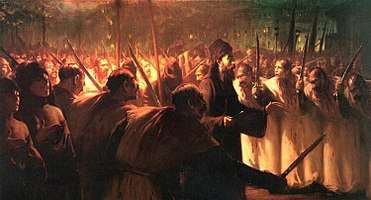
Newruz "New Day" is the Kurdish New Year observed on 21 March (the Spring equinox) as a celebration of newness and reconciliation. It is celebrated by many modern Turkic peoples as well. Apart from the original beliefs of the Zoroastrians regarding the New Year, Alevis also celebrate and commemorate the birth of Ali, his wedding with Fatima, the rescue of Yusuf from the well, and the creation of the world on this day. Various cem ceremonies and special programs are held.
Mourning of Muharram
The Muslim month of Muharram begins 20 days after Eid ul-Adha (Kurban Bayramı). Alevis observe a fast for the first twelve days. This is called "Turkish: Muharrem Mâtemi", "Turkish: Yâs-ı Muharrem" or "Turkish: Mâtem Orucu" (Mourning of Muharram). This culminates in the festival of Ashura (Aşure), which commemorates the martyrdom of Husayn at Karbala. The fast is broken with a special dish (also called aşure) prepared from a variety (often twelve) of fruits, nuts, and grains. Many events are associated with this celebration, including the salvation of Husayn's son Ali ibn Husayn from the massacre at Karbala, thus allowing the bloodline of the family of Muhammad to continue.
Hıdırellez
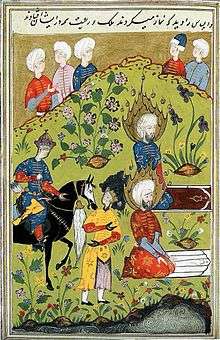
Hıdırellez honors the mysterious figure Khidr (Turkish: Hızır) who is sometimes identified with Elijah (Ilyas), and is said to have drunk of the water of life. Some hold that Khidr comes to the rescue of those in distress on land, while Elijah helps those at sea; and that they meet at a rose tree in the evening of every 6 May. The festival is also celebrated in parts of the Balkans by the name of "Erdelez," where it falls on the same day as Đurđevdan or St. George's Day.
Khidr is also honored with a three-day fast in mid-February called Hızır Orucu. In addition to avoiding any sort of comfort or enjoyment, Alevis also abstain from food and water for the entire day, though they do drink liquids other than water during the evening.
Note that the dates of the Khidr holidays can differ among Alevis, most of whom use a lunar calendar, but some a solar calendar.
Müsahiplik
Müsahiplik (roughly, "Companionship") is a covenant relationship between two men of the same age, preferably along with their wives. In a ceremony in the presence of a dede the partners make a lifelong commitment to care for the spiritual, emotional, and physical needs of each other and their children. The ties between couples who have made this commitment is at least as strong as it is for blood relatives, so much so that müsahiplik is often called spiritual brotherhood (manevi kardeşlik). The children of covenanted couples may not marry.[40]
Krisztina Kehl-Bodrogi reports that the Tahtacı identify müsahiplik with the first gate (şeriat), since they regard it as a precondition for the second (tarikat). Those who attain to the third gate (marifat, "gnosis") must have been in a müsahiplik relationship for at least twelve years. Entry into the third gate dissolves the müsahiplik relationship (which otherwise persists unto death), in a ceremony called Öz Verme Âyini ("ceremony of giving up the self").
The value corresponding to the second gate (and necessary to enter the third) is âşinalık ("intimacy," perhaps with God). Its counterpart for the third gate is called peşinelik; for the fourth gate (hâkikat, Ultimate Truth), cıngıldaşlık or cengildeşlik (translations uncertain).[41]
Folk practices
Many folk practices may be identified, though few of them are specific to the Alevis. In this connection, scholar Martin van Bruinessen notes a sign from Turkey's Ministry of Religion, attached to Istanbul's shrine of Eyüp Sultan, which presents
...a long list of ‘superstitious’ practices that are emphatically declared to be non-Islamic and objectionable, such as lighting candles or placing ‘wishing stones’ on the tomb, tying pieces of cloth to the shrine or to the trees in front of it, throwing money on the tomb, asking the dead directly for help, circling seven times around the trees in the courtyard or pressing one’s face against the walls of the türbe in the hope of a supernatural cure, tying beads to the shrine and expecting supernatural support from them, sacrificing roosters or turkeys as a vow to the shrine. The list is probably an inventory of common local practices the authorities wish to prevent from re-emerging.[42]
Other, similar practices include kissing door frames of holy rooms; not stepping on the threshold of holy buildings; seeking prayers from reputed healers; and making lokma and sharing it with others.
Ziyarat to sacred places
Performing ziyarat and du'a at the tombs of Alevi-Bektashi saints or pirs is quite common. Some of the most frequently visited sites are the shrines of Şahkulu and Karacaahmet (both in Istanbul), Abdal Musa (Antalya), Battal Gazi (Eskişehir), the annual celebrations held at Hacıbektaş (16 August) and Sivas (the Pir Sultan Abdal Kültür Etkinlikleri, 23–24 June).
In contrast with the traditional secrecy of the Cem ceremony ritual, the events at these cultural centers and sites are open to the public. In the case of the Hacibektaş celebration, since 1990 the activities there have been taken over by Turkey's Ministry of Culture in the interest of promoting tourism and Turkish patriotism rather than Alevi spirituality.
Some Alevis make pilgrimages to mountains and other natural sites believed to be imbued with holiness.
Almsgiving
Alevis are expected to give Zakat but not in the Orthodox-Islamic sense rather there is no set formula or prescribed amount for annual charitable donation as there is in Orthodox Islam (2.5% of possessions above a certain minimum). Rather, they are expected to give the 'excess' according to Qur'an verse 2:219. A common method of Alevi almsgiving is through donating food (especially sacrificial animals) to be shared with worshippers and guests. Alevis also donate money to be used to help the poor, to support the religious, educational and cultural activities of Alevi centers and organizations (dergâh, vakıf, dernek), and to provide scholarships for students.
Society
Leadership structure
In contrast to the Bektashi tariqa, which like other Sufi orders is based on a silsila "initiatory chain or lineage" of teachers and their students, Alevi leaders succeed to their role on the basis of family descent. Perhaps ten percent of Alevis belong to a religious elite called ocak "hearth", indicating descent from Ali and/or various other saints and heroes. Ocak members are called ocakzades or "sons of the hearth". This system apparently originated with Safavid Persia.
Alevi leaders are variously called murshid, pir, rehber or dede. Groups that conceive of these as ranks of a hierarchy (as in the Bektashi tariqa) disagree as to the order. The last of these, dede "grandfather", is the term preferred by the scholarly literature. Ocakzades may attain to the position of dede on the basis of selection (by a father from among several sons), character, and learning. In contrast to Alevi rhetoric on the equality of the sexes, it is generally assumed that only males may fill such leadership roles.
Traditionally Dedes did not merely lead rituals, but led their communities, often in conjunction with local notables such as the ağas (large landowners) of the Dersim Region. They also acted as judges or arbiters, presiding over village courts called Düşkünlük Meydanı.
Ordinary Alevi would owe allegiance to a particular dede lineage (but not others) on the basis of pre-existing family or village relations. Some fall instead under the authority of Bektashi dargah (lodges).
In the wake of 20th century urbanization (which removed young laborers from the villages) and socialist influence (which looked upon the Dedes with suspicion), the old hierarchy has largely broken down. Many Dedes now receive salaries from Alevi cultural centers, which arguably subordinates their role. Such centers no longer feature community business or deliberation, such as the old ritual of reconciliation, but emphasize musical and dance performance to the exclusion of these.[43] Dedes are now approached on a voluntary basis, and their role has become more circumscribed – limited to religious rituals, research, and giving advice.
| Part of a series on Islam Sufism |
|---|
|
List of sufis |
|
|
.jpg)
Position of women
According to John Shindeldecker "Alevis are proud to point out that they are monogamous, Alevi women are encouraged to get the best education they can, and Alevi women are free to go into any occupation they choose."[44]
Relations with other Muslim groups
Alevis are classified as a sect of Shia Islam,[45] as Alevis accept Twelver Shi‘a beliefs about Ali and the Twelve Imams, and Ayatollah Ruhollah Khomeini decreed Alevis to be part of the Shia fold in the 1970s.[32] However, Alevi philosophies, customs, and rituals are appreciably different than those of mainstream, orthodox Ja'fari-Twelver Shi‘ah. According to more orthodox Shia Muslims, Alevis are labeled as "Batiniyya" groups since Alevis praise Ali beyond what mainstream Shia Muslims expect. According to Alevis, Ali and Muhammad are likened to the two sides of a coin, or the two halves of an apple.
Sufi elements in Alevism
Despite this essentially Shi‘i orientation, much of Aleviness' mystical language is inspired by Sufi traditions. For example, the Alevi concept of God is derived from the philosophy of Ibn Arabi and involves a chain of emanation from God, to spiritual man, earthly man, animals, plants, and minerals. The goal of spiritual life is to follow this path in the reverse direction, to unity with God, or Haqq (Reality, Truth). From the highest perspective, all is God (see Wahdat-ul-Wujood). Alevis admire Mansur Al-Hallaj, a 10th-century Sufi who was accused of blasphemy and subsequently executed in Baghdad for saying "I am the Truth" (Ana al-Haqq).
There is some tension between folk tradition Aleviness and the Bektashi Order, which is a Sufi order founded on Alevi beliefs.[46] In certain Turkish communities other Sufi orders (the Halveti-Jerrahi and some of the Rifa'i) have incorporated significant Alevi influence.
Relations with majority Sunnis
The relationship between Alevis and Sunnis is one of mutual suspicion and prejudice dating back to the Ottoman period. Hundreds of Alevis were murdered in sectarian violence in the years that preceded the 1980 coup, and as late as the 1990s dozens were killed with impunity.[5] While pogroms have not occurred since them, the Erdogan has declared “a cemevi is not a place of worship, it is a center for cultural activities. Muslims should only have one place of worship.”[5]
Alevis claim that they have been subject to intolerant Sunni "nationalism" that has been unwilling to recognize Alevi "uniqueness."[47]
History
Alevis have been victims of pogroms during both Ottoman times and under the Turkish republic up until the 1990.[5][48][49]
Seljuk period
During the great Turkish expansion from Central Asia into Iran and Anatolia in the Seljuk period (11–12th centuries), Turkmen nomad tribes accepted a Sufi and pro-Ali form of Islam that co-existed with some of their pre-Islamic customs. Their conversion to Islam in this period was achieved largely through the efforts not of textual scholars (ulema) expounding the finer points of Koranic exegesis and shari‘a law, but by charismatic Sufi dervishes whose cult of Muslim saint worship, mystical divination and millenarianism spoke more directly to the steppe mindset. These tribes dominated Anatolia for centuries with their religious warriors (ghazi) spearheading the drive against Byzantines and Crusaders.[50]
Ottoman period
As in Khorasan and West Asia before, the Turkmens who spearheaded the Ottomans’ drive into the Balkans and West Asia were more inspired by a vaguely Shiite folk Islam than by formal religion. Many times, Ottoman campaigns were accompanied or guided by Bektaşi dervishes, spiritual heirs of the 13th century sufi saint Haji Bektash Veli, himself a native of Khorasan. After the conquest of Constantinople in 1453, the Ottoman state became increasingly determined to assert its fiscal but also its juridical and political control over the farthest reaches of the Empire. The resulting Qizilbash revolts, a series of millenarian anti-state uprisings by the heterodox Turkmen population of Anatolia that culminated in the establishment of a militantly Shiite rival state in neighbouring Iran.[50] The Ottoman Empire later proclaimed themselves its defenders against the Safavid Shia state and related sects. This created a gap between the Sunni Ottoman ruling elite and the Alevi Anatolian population. Anatolia became a battlefield between Safavids and Ottomans, each determined to include it in their empire.
Republic
According to Eren Sarı, Alevi saw Kemal Atatürk as a Mahdi "savior sent to save them from the Sunni Ottoman yoke".[33] However, pogroms against Alevi did not cease after the establishment of Atatürk's republic. In attacks against leftists in the 1970s, ultranationalists and reactionaries killed many Alevis. Malatya in 1978, Maraş in 1979, and Çorum in 1980 witnessed the murder of hundreds of Alevis, the torching of hundreds of homes, and lootings.[48][49]
When he came to power in 2003, then Prime Minister Recep Tayyip Erdogan initially promised to strengthen the rights of minorities. In 2007 he began an “Alevi opening,” and has protected Alevi from massacres.[5] But the Erdogan government also emphasizes the teaching of Sunni doctrine in public schools,[5] has placed few Alevis in government positions such as governor or police chief; and while it spends large sums for the construction of Sunni mosques, refuses to classify cemevis as official places of worship, let alone pay for their construction.[5] In October 2013, tens of thousands of Alevis protested the lack of Alevi rights in a series of reforms introduced by Erdoğan.[7] In 2015 a cemevi was confiscated and repurposed as a mosque, despite the presence of another mosque a few hundred metres away.[5] In 2016 the European Court of Human Rights (ECHR) found that Alevis in Turkey "were subjected to a difference in treatment for which there was no objective and reasonable justification."[51]
Demographics
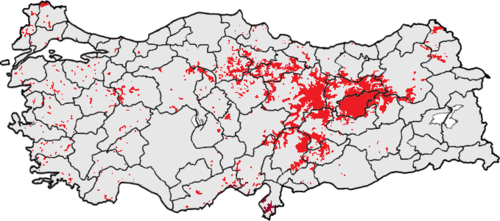
Most Alevi live in Turkey, where they are a minority and Sunni Muslims the majority. The size of the Alevi population is likewise disputed, but most estimates place them somewhere between 8 and 10 million people or about 12% of the population.[52][53] Estimates of the percentage of Turkey's population that are Alevi include between 10–20%,[5] 33%,[54] and as much as 40%.[54] Scattered minorities live in Bulgaria, Cyprus, the Caucasus, Greece, Iran and the Turkish Diaspora.[55]
Most Alevis come from Kizilbash or Bektashi origin, according to Minorityrights.org. The Alevis (Kizilbash) are traditionally predominantly rural and acquire identity by parentage. Bektashis, however, are predominantly urban, and formally claim that membership is open to any Muslim. The groups are separately organized, but subscribe to "virtually the same system of beliefs".[54]
Population estimates
The Alevi population has been estimated as follows:
- 12,521,000 according to Sabahat Akkiraz, an MP from CHP.[56]
- "approx. 15 million..." —Krisztina Kehl-Bodrogi.[57]
- In Turkey, 15% of Turkey's population (approx. 10.6 million) —David Shankland[58]
- "Most Alevi writers and spokespersons claim that Turkey's population today is one-third Alevi-Bektashi, or more than 20 million. Lower estimates range from 10 to 12 million." —John Schindeldecker.[59]
- "The Alevi constitute the second-largest religious community in Turkey (following the Sunnis), and number some 25% (15 million) of the total population (Alevis claim 30%–40%). Most (?) Alevis are ethnic and linguistic Turks, mainly of Turkmen descent from Central and Eastern Anatolia. Some 20% of Alevis are Kurds (though most Kurds are Sunni), and some 25% of Kurds in Turkey are Alevi (Kurmanji and Zaza speakers)." —David Zeidan.[60]
- "8 to 10 million..." —Olli Rehn, from the 1996 (Camiel) "Eurlings Report" to the European Commission (on the suitability of Turkish accession to the EU).
- "...a world total of between 10 and 15 million adherents. There is no independent data for their numbers, so these statistics are estimates or conjectures." —"Alevism," from The Encyclopedia of the Orient.
- In June 2008, several Turkish newspapers reported that the Turkish military had commissioned three universities to research the ethnic demography of Turkey. The study was done in 2000 and included all ethnic groupings. According to the results, the Alevi population of Turkey, including those who currently reside in Europe, is around 10 million.
- Conglomeration of syncretic beliefs: A wide variety of academic sources define Alevism as a syncretic religion, combining diverse religious beliefs,[61][62][63] which developed from Islam, Buddhist-influenced Turkic shamanism, and some elements of Christianity.[64][65][66] According to Turkish university research conducted in 2005 by a researcher named Soner Cagaptay, 44% of respondents who called themselves "Alevis" self-identify as Muslim and 56% do not.[67] Nevertheless, one should be aware of the fact that the university survey which was conducted at a specific location may not reflect the accurate results all the time, and there exists a high probability that the group who had been surveyed might belong to the non-Muslim Ishikists. Moreover, one should always bear in mind that some members of the non-muslim communities like Kurdish Yâresân (Ahl-i Haqq) and Ishik-Alevis define/identify themselves under the title of Alawism as well. Henceforth, it is always possible either to enlarge or to shrink the borders of the Alevism with respect to which of these definitions are going to be used.
- Alevis have been subjected to persecution (often deadly) for centuries. Due to this fact, some have been assimilated. It is not clear how effective the above study is in including those who might be more timid about advertising their Alevi origins.
- Some of the Kurdish Alevis speak Kurmanji or Zazaki. Some Alevis are Azeris.[68] Despite universalist rhetoric and in contrast with Islam in general, or the Bektashi order, Alevi communities do not generally acknowledge the possibility of conversion to Aleviness.
- Alevi communities are concentrated in central Anatolia, in a belt from Çorum in the west to Muş in the east. The only province within Turkey with an Alevi majority is Tunceli, formerly known as Dersim. Beginning in the 1960s, many Alevis have migrated to the large cities of western and southern Turkey – and to western Europe, especially Germany – and are now heavily urbanized.
- There is also a native 3000 Alevi community in Western Thrace, Greece.[69]
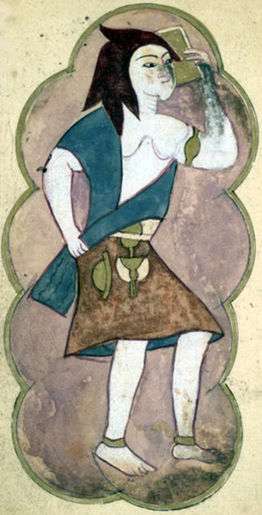
Social groups
A Turkish scholar working in France has distinguished four main groups among contemporary Alevis, which cautiously show their distinctive features in modern Turkey.[70]
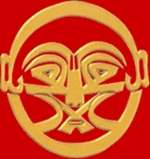
- The first group, who form majority of the Alevi population regard themselves as true Muslims and are prepared to cooperate with the state. It adheres to the way of Jafar as-Sadiq, the Sixth Imam of Shia Islam. This groups, concept of God is the same as Orthodox Islam, and like their Shia counterparts they reject the first three chosen Caliph's, who Sunni's accept as legitimate and only accept Ali as the actual and true Caliph.[70]
- The second group, which has the second most following among Alevis are said to be under the active influence of the official Iranian Shia's and to be confirmed adherents of the Twelver branch of Shia Islam and they reject the teachings of Bektashism Tariqa. They follow the Ja'fari jurisprudence and oppose secular state power.[70]
- The third group a minority belief held by the Alevis is mainly represented by people who belong to the political left and presumed the Aleviness just as an outlook on the individual human life rather than a religious conviction by persistently renouncing the ties of the Batiniyya-Alevism with Twelver political branch of Shia Islam. The followers of this congregation, who later turned out to be the very stern defenders of Erdoğan Çınar, hold ritual unions of a religious character and have established cultural associations named after Pir Sultan Abdal as well. According to their philosophy, human being should enjoy a central role reminiscent of the doctrine of Khurramites, and as illustrated by Hurufi phrase of God is Man quoted above in the context of the Trinity.[70]
- The fourth who adopted some aspirations of Christian mysticism, is more directed towards heterodox mysticism and stands closer to the Hajji Bektashi Brotherhood. According to the philosophy developed by this congregation, Christian mystic St Francis of Assisi and Hindu Mahatma Gandhi are supposedly considered better believers of God than many Muslims.[70]
Influences of the Muslim sects on the Alevī faith throughout Anatolia and the Balkans
| The influences of the Muslim sects on the Alevī faith throughout Anatolia and the Balkans |
|---|
|
The schematic history of the development of the Imāmī-Alevism |
Bektashi
The Bektashiyyah is a Shia Sufi order founded in the 13th century by Haji Bektash Veli, a dervish who escaped Central Asia and found refuge with the Seljuks in Anatolia at the time of the Mongol invasions (1219–23). This order gained a great following in rural areas and it later developed in two branches: the Celebi clan, who claimed to be physical descendants of Haji Bektash Veli, were called Bel evladları (children of the loins), and became the hereditary spiritual leaders of the rural Alevis; and the Babağan, those faithful to the path (yol evladları – children of the way) who dominated the official Bektashi Sufi order with its elected leadership.[31]
Bektashiyyah doctrine: Bektashism and Hurufism
The Bektashi Order is a Sufi order and shares much in common with other Islamic mystical movements, such as the need for an experienced spiritual guide – called a baba in Bektashi parlance – as well as the doctrine of "the four gates that must be traversed": the "Sharia" (religious law), "Tariqah" (the spiritual path), "Marifa" (true knowledge), "Haqiqah" (truth).
Wahdat al-Mawjud
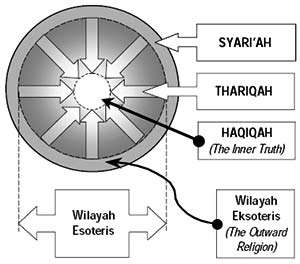
Bektashism places much emphasis on the concept of Wahdat al-Mawjud وحدة الوجود, the "Unity of Being" that was formulated by Ibn Arabi. Bektashism is also heavily permeated with Shiite concepts, such as the marked veneration of Ali, the Twelve Imams, and the ritual commemoration of Ashurah marking the Battle of Karbala. The old Persian holiday of Nowruz is celebrated by Bektashis as Imam Ali's birthday.
In keeping with the central belief of Wahdat Al-Mawjud the Bektashi see reality contained in Haqq-Muhammad-Ali, a single unified entity. Bektashi do not consider this a form of trinity. There are many other practices and ceremonies that share similarity with other faiths, such as a ritual meal (muhabbet) and yearly confession of sins to a baba (magfirat-i zunub مغفرة الذنوب). Bektashis base their practices and rituals on their non-orthodox and mystical interpretation and understanding of the Qur'an and the prophetic practice (Sunnah). They have no written doctrine specific to them, thus rules and rituals may differ depending on under whose influence one has been taught. Bektashis generally revere Sufi mystics outside of their own order, such as Ibn Arabi, Al-Ghazali and Jelalludin Rumi who are close in spirit to them.
Batiniyya and Ismailism
Bektashis hold that the Qur'an has two levels of meaning: an outer (Zāher ظاهر) and an inner (bāṭen باطن).[6] They hold the latter to be superior and eternal and this is reflected in their understanding of both the universe and humanity, which is a view that can also be found in Ismailism and Batiniyya.[25]
Bektashism is also initiatic and members must traverse various levels or ranks as they progress along the spiritual path to the Reality. First level members are called aşıks عاشق. They are those who, while not having taken initiation into the order, are nevertheless drawn to it. Following initiation (called nasip) one becomes a mühip محب. After some time as a mühip, one can take further vows and become a dervish. The next level above dervish is that of baba. The baba (lit. father) is considered to be the head of a tekke and qualified to give spiritual guidance (irshad إرشاد). Above the baba is the rank of halife-baba (or dede, grandfather). Traditionally there were twelve of these, the most senior being the "dedebaba" (great-grandfather). The dedebaba was considered to be the highest ranking authority in the Bektashi Order. Traditionally the residence of the dedebaba was the Pir Evi (The Saint's Home) which was located in the shrine of Hajji Bektash Wali in the central Anatolian town of Hacıbektaş (Solucakarahüyük).
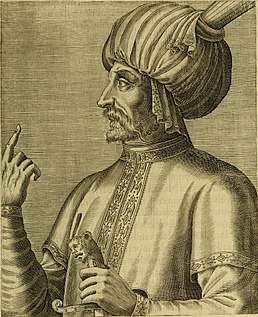
Qizilbash
The Qizilbash (red-heads) were Turkmen tribes who adhered to the Safavid Sufi Order, whose Sheikhs claimed descent from Ali. Under Isma`il (d. 1524) they became dominant in Eastern Anatolia and conquered Azerbaijan with its capital Tabriz, where Isma`il named himself Shah in 1501 and went on to conquer all of Iran. His missionaries spread a message of revolt against the Sunni Ottomans in Anatolia, claiming that Isma`il was the awaited mahdi (messiah), and Anatolia became the scene of protracted warfare between Ottomans and Safavids.[31]
Qizilbash doctrine: Kızılbaşlık
Qizilbash and Bektashi tariqah shared common religious beliefs and practices becoming intermingled as Alevis in spite of many local variations. Isolated from both the Sunni Ottomans and the Twelver Shi`a Safavids, Qizilbash and Bektashi developed traditions, practices, and doctrines by the early 17th century which marked them as a closed autonomous religious community. As a result of the immense pressures to conform to Sunni Islam, all members of Alevism developed a tradition of opposition (ibāḥa) to all forms of external religion.[31]
The doctrine of Qizilbashism is well explained in the following poem written by the Shaykh of Safaviyya tariqah Ismail I:
من داها نسنه بيلمه زه م / Mən daha nəsnə bilməzəm, // I don't know any other object,
آللاه بير محممد على́دير / Allah bir Məhəmməd Əlidir. // Allah is unique Muhammad-Ali.
اؤزوم غوربتده سالمازام / Özüm qürbəttə salmazam, // I can't let out my own essence to places far from my homeland,
آللاه بير محممد على́دير / Allah bir Məhəmməd Əlidir. // Allah is unique Muhammad-Ali.
اونلار بيردير، بير اولوبدور / Onlar birdir, bir olubdur, // They are unique, a single one, i.e. Haqq-Muhammad-Ali,
يئردن گؤيه نور اولوبدور / Yerdən göyə nur olubdur, // It's a nūr from Earth to Sky,
دؤرد گوشه ده سيرر اولوبدور، / Dörd guşədə sirr olubdur, // It's a mysterious occult secret in every corner of the square,
آللاه بير محممد على́دير / Allah bir Məhəmməd Əlidir. // Allah is unique Muhammad-Ali.
ختايى بو يولدا سردير / Xətai bu yolda sirdir, // Khatai in this tariqah is a mysterious occult secret,
سرين وئره نلر ده اردير / Sirrin verənlər də ərdir, // Those reveal their own secret are private as well,
آيدا سيردير، گونده نوردور / Ayda sirdir, gündə nurdur, // Secret on Moon, nūr on Sun,
آللاه بير محممد على́دير / Allah bir Məhəmməd Əlidir. // Allah is unique Muhammad-Ali.
The lines of poetry above may easily be judged as an act of "Shirk" (polytheism) by the Sunni Ulama, but they have a bāṭenī[6] taʾwīl (inner explanation) in Qizilbashism.
Alevi music
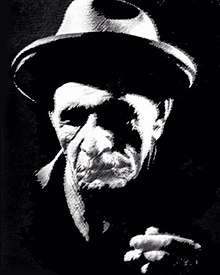
Alevi religious services, referred to collectively as cem or âyîn, include spiritual exercises that incorporate elements of zikr ("remembrance" or recitation of God's names, in this case without controlled breathing, but with some elements of body posturing) and sema (ritual dance). The latter is accompanied by sung mystical poetry in the vernacular, and by the sacred ritual instrument known as bağlama or saz (a plucked folk lute with frets).
Such music is performed by specialists known as zâkir, aşık, sazende or güvende, depending on regional usage. They are recruited from Alevi communities and descended from dede lineages. Many are also known to be poet/minstrels (aşık, ozan) who perpetuate the tradition of dervish-lodge (tekke) poets such as Yunus Emre (13th century), Nesîmî (14th century), Pir Sultan Abdal, Hatâ'î and Genç Abdal (16th century) and Kul Himmet and Kul Hüseyn (17th century). The poetry was composed in the Turkish vernacular and follows the principles of folk prosody known as hece vezne in which the focus is the number of syllables.
The specialized sacred musical repertoire of Alevi musicians includes
- Deyiş (songs of mystical love)
- Nefes (hymns concerning the mystical experience)
- Düvaz or dıwes imâm (hymns in honor of the 12 Alid imams)
- Mersiye (laments concerning the martyrdom of Imam Huseyn at Karbala)
- Miraçlama (songs about the ascent of the Muhammad to heaven)
- Samāh (ritual dance accompanied by folk lutes and sung poetry)
The dances are performed by couples, and choreographies employ circle and line formations as well as arrangements where couples face one another, thus synchronizing their movements more closely. As the tempo of the music increases, the figures become more complex and intense. There are many regional variants of sema, but the most widespread and important are the Dance of the Forty (Kırklar Semahı) and the Dance of the Cranes (Turnalar Semahı).
The âyîn-î-cem can be heard on the JVC CD Turkey – An Esoteric Sufi Ceremony. The recording was made in Istanbul in 1993, and the ceremony includes in an order typical of a cem: a deyiş that reiterates the line of descent of the sect in a historical framework, two divas (one based on the poetry of Hatâ'î, and the other on the poetry of Kul Himmet), prayer formulas, the ill-Âllâh genre that incorporates the tahlîl formula into the poem to create an atmosphere of zikr while sect members create rhythmic intensity by hitting their knees in time to the music and sway their bodies slightly, the Dance of the Forty (Kırklar Semah), the Dance of the Cranes (Turnalar Semahı) and prayer formulas.
Alevis have a significant role in Turkish music and poetry. Pir Sultan Abdal, a 16th-century Alevi poet whose poems and songs often contain spiritual themes, is revered as a saint and hero. Important figures are the Sufi poet Yunus Emre, widely regarded as having been Alevi, and Kaygusuz Abdal. Their poems shape Turkish culture up to now, and are also performed by modern artists. Songs attributed to these poets have been embraced by left-wingers in the 20th century. The aşık bards are also influenced by Alevi tradition.
Many of the major traditional musicians in Turkey are Alevi, including Arif Sağ, Musa Eroğlu, Neşet Ertaş,[77] Erdal Erzincan, Aşık Mahzuni Şerif, Aşık Feyzullah Çınar, Aşık Veysel Şatıroğlu, Ali Ekber Çiçek, Sabahat Akkiraz, Belkıs Akkale, and Ulaş Özdemir. Other non-Alevis, such as Ruhi Su, have recorded many Alevi songs. Mercan Dede, an artist whose music combines electronic and traditional Sufi elements, has made some songs involving Alevi themes in cooperation with singer Sabahat Akkiraz.
| The historical emergence of the Alevī Ṭarīqah |
|---|
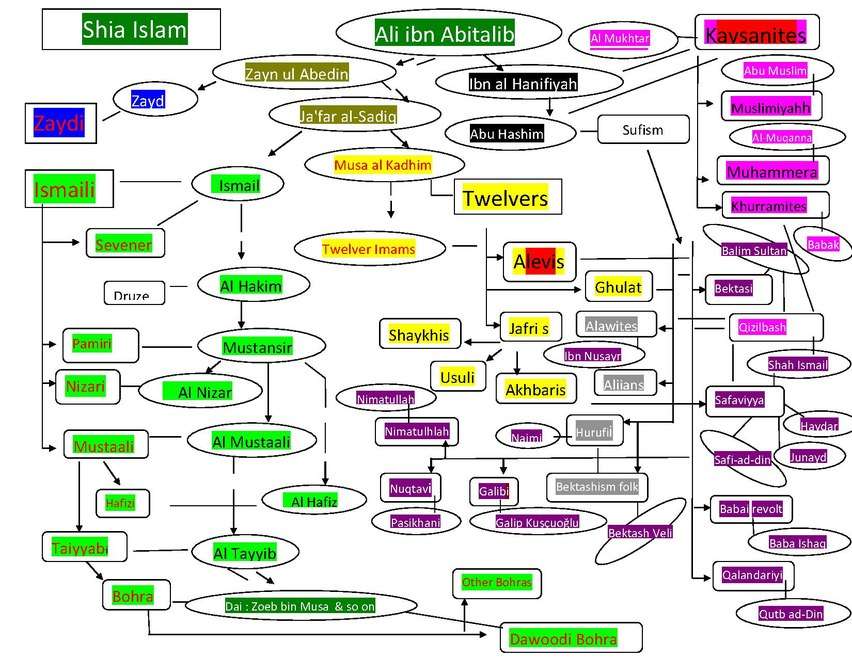
See also
- Ashura
- Duzgin Bawo
- Religious humanism
- Shi'a view of Ali
References
- Anadolu Kızılbaşlığı or simply Kızılbaşlık would better represent the majority of their members.
- Abdurrahman Adak (2015). "Ekola Aqtepeyê ya Edebiyatê û hizra Kurdîtî-Elewîtî-Neqşebendîtiyê". Nûbihar (in Kurdish): 10–15.
- "The Alevis". www.guidetomuslimdiversity.com.au. Archived from the original on 2017-03-25. Retrieved 2017-07-27.
- "BEKTĀŠĪYA". Archived from the original on 17 May 2015. Retrieved 5 March 2015.
- KINGSLEY, PATRICK (22 July 2017). "Turkey's Alevis, a Muslim Minority, Fear a Policy of Denying Their Existence". New York Times. Retrieved 27 July 2017.
- Radtke, B. "Bāṭen". Encyclopedia Iranica. Retrieved 9 July 2014.
- "Alevism". Harvard Divinity School Religious Literacy Project. Retrieved 2017-07-31.
- Barkey, Henri J. (2000). Turkey's Kurdish Question. Rowman & Littlefield Publishers. p. 67. ISBN 9780585177731.
- Jorgen S Nielsen Muslim Political Participation in Europe Edinburgh University Press 2013 ISBN 978-0-748-67753-5 page 255
- Rasim Ösgür Dönmez, Fazilet Ahu Özmen Gendered Identities: Criticizing Patriarchy in Turkey Lexington Books 2013 ISBN 978-0-739-17563-7 page 150
- "Excerpts from Baba Rexheb's The Mysticism of Islam & Bektashism – The Bektashi Order of Dervishes". Archived from the original on 28 February 2015. Retrieved 5 March 2015.
- "Alevitisme: De vijf zuilen? (met NL ondertiteling)". YouTube. 12 July 2013. Retrieved 5 March 2015.
- Cagaptay, Soner (17 April 2012). "Are Syrian Alawites and Turkish Alevis the same?". CNN. Retrieved 2017-07-28.
- Hande Sözer Managing Invisibility: Dissimulation and Identity Maintenance among Alevi Bulgarian Turks BRILL 2014 ISBN 978-9-004-27919-3 page 114
- Tord Olsson, Elisabeth Ozdalga, Catharina Raudvere Alevi Identity: Cultural, Religious and Social Perspectives Tord Olsson, Elisabeth Ozdalga, Catharina Raudvere ISBN 978-1-135-79725-6 page 25
- These and many other quotations may be found in John Shindeldecker's Turkish Alevis Today.
- Aksu, İbrahim. "Differences & Similarities Between Anatolian Alevis & Arab Alawites: Comparative Study on Beliefs and Practices". www.academia.edu.
- Tord Olsson, Elisabeth Ozdalga, Catharina Raudvere Alevi Identity: Cultural, Religious and Social Perspectives Tord Olsson, Elisabeth Ozdalga, Catharina Raudvere ISBN 978-1-135-79725-6 page 72
- Shindeldecker, John. "Turkish Alevis Today". www.alevibektasi.eu.
- "Aleviliğin doğuş yeri Anadolu değildir". Alevi İslam Din Hizmetleri Başkanlığı. Retrieved 5 March 2015.
- Alevi-Islam Religious Services – The message of İzzettin Doğan, Zafer Mah. Ahmet Yesevi Cad. No: 290, Yenibosna / Istanbul, Turkey.
- Powell, Russell (2016). Shariʿa in the Secular State: Evolving Meanings of Islamic Jurisprudence in . Routledge. p. 35. ISBN 9781317055693. Retrieved 27 July 2017.
- "Muhammad ibn Āliyy’ūl Cillī aqidah" of "Maymūn ibn Abu’l-Qāsim Sulaiman ibn Ahmad ibn at-Tabarānī fiqh" (Sūlaiman Affandy, Al-Bākūrat’ūs Sūlaiman’īyyah – Family tree of the Nusayri Tariqat, pp. 14–15, Beirut, 1873.)
- Both Muhammad ibn Āliyy’ūl Cillī and Maymūn ibn Abu’l-Qāsim’at-Tabarānī were the murids of Al-Khaṣībī, the founder of the Nusayri tariqat.
- Halm, H. "BĀṬENĪYA". Encyclopedia Iranica. Retrieved 1 May 2015.
- "Abu'l-Khāttāb Asadī". Retrieved 5 March 2015.
- "ḴAṬṬĀBIYA". Retrieved 5 March 2015.
- "ʿABDALLĀH B. MAYMŪN AL-QADDĀḤ". Archived from the original on 2018-05-16. Retrieved 5 March 2015.
- Roger M. Savory (ref. Abdülbaki Gölpinarli), Encyclopaedia of Islam, "Kizil-Bash", Online Edition 2005
- Öztürk, Yaşar Nuri, En-el Hak İsyanı (The Anal Haq Rebellion) – Hallâc-ı Mansûr (Darağacında Miraç – Miraç on Gallows), Vol 1 and 2, Yeni Boyut, 2011.
- "The Alevi of Anatolia". angelfire.com. Archived from the original on 23 April 2012. Retrieved 27 June 2014.
- Nasr, V: "The Shia Revival," page 1. Norton, W. W. & Company, Inc, 2006
- Sarı, Eren (2017). The Alevi Of Anatolia: During the great Turkish expansion from Central Asia . noktaekitap. p. 16. Retrieved 27 July 2017.
- Gettleman, Jeffrey (2012-08-04). "Turkish Alawites Fear Spillover of Violence From Syria". The New York Times. ISSN 0362-4331. Retrieved 2017-07-28.
- Jones, Dorian (22 March 2012). "Alevi Turks concerned for Alawi 'cousins' in Syria | Globalization | DW |". Deutsche Welle. Retrieved 2017-07-28.
- van Bruinessen, Martin (c. 1995). "Kurds, Turks, and the Alevi Revival in Turkey". islam.uga.edu. Archived from the original on 2014-05-12. Retrieved 2017-07-31.
- Also see, Öztürk, ibid, pp. 78–81. In the old days, marrying a Sunni [Yezide kuşak çözmek] was also accepted as an offense that led to the state of düşkün. See Alevi Buyruks
- Kristina Kehl-Bordrogi reports this among the Tahtacı. See her article "The significance of müsahiplik among the Alevis" in Synchronistic Religious Communities in the Near East (co-edited by her, with B. Kellner-Heinkele & A. Otter-Beaujean), Brill 1997, p. 131 ff.
- "Turkey's Alevis beholden to politics".
- Krisztina Kehl-Bodrogi. 1988. Die Kizilbash/Aleviten, pp. 182–204.
- See again "The significance of müsahiplik among the Alevis" in Synchronistic Religious Communities in the Near East (co-edited by her, with B. Kellner-Heinkele & A. Otter-Beaujean), Brill 1997, p. 131 ff.
- Religious practices in the Turco-Iranian World, 2005.
- See Martin Stokes' study.
- Flows, Capital. "Religious Diversity And The Alevi Struggle For Equality In Turkey". Forbes. Retrieved 2020-01-01.
- Miller, Tracy, ed. (October 2009). "Mapping the Global Muslim Population: A Report on the Size and Distribution of the World's Muslim Population, Pew Research Center" (PDF). Archived from the original (PDF) on 2009-10-10. Retrieved 2009-10-08.
- Ataseven, I: "The Alevi-Bektasi Legacy: Problems of Acquisition and Explanation", page 1. Coronet Books Inc, 1997
- Karin Vorhoff. 1995. Zwischen Glaube, Nation und neuer Gemeinschaft: Alevitische Identitat in der Türkei der Gegenwart, pp. 95–96.
- "Pir Sultan Abdal Monument and Festival". memorializeturkey.com. Archived from the original on 14 July 2014. Retrieved 27 June 2014.
- Rana Birden Çorbacıoğlu, Zeynep Alemdar. "ALEVIS AND THE TURKISH STATE" (PDF). turkishpolicy.com. Retrieved 27 June 2014.
- https://ebookshia.com/upload/bookFiles/656/شيعه_لبنان_زير_سلطه_عثماني.PDF
- Hallam, Mark (26 April 2016). "Turkey discriminates against Alevi faith, ECHR rules". DW. Retrieved 31 July 2017.
- "Turkey: International Religious Freedom Report 2007". State.gov. Retrieved 9 August 2011.
- "Turkey's Alevi strive for recognition". Asia Times Online. 18 February 2010. Retrieved 9 August 2011.
- "Turkey – Alevis". World Directory of Minorities and Indigenous Peoples. Retrieved 27 July 2017.
- Massicard, Elise (2012-10-12). The Alevis in Turkey and Europe: Identity and Managing Territorial Diversity. googlebooks.com. Google Books. ISBN 9781136277986. Retrieved 5 June 2014.
- "Sabahat Akkiraz'dan Alevi raporu". haber.sol.org.tr. Retrieved 25 June 2014.
- From the introduction of Syncretistic Religious Communities in the Near East edited by her, B. Kellner-Heinkele, & A. Otter-Beaujean. Leiden: Brill, 1997.
- Structure and Function in Turkish Society. Isis Press, 2006, p. 81.
- From his Turkish Alevis Today.
- "The Alevi of Anatolia," 1995.
- Formation of Alevi Sycretism, Ceren Selmanpakoglu, 2006
- "Alevism " Hannah Arendt Center for Politics and Humanities". Retrieved 5 March 2015.
- The making of world society; Anghel, Gerharz et al.; Transaction Publishers; 2008; page 106
- "Are Syrian Alawites and Turkish Alevis the Same?". Retrieved 5 March 2015.
- Soner Cagaptay, The Rise of Turkey: The Twenty-First Century's First Muslim Power, p. 85. Date=?
- Struggling for recognition, Sokefeld, Berghahn books, 2008, page 103
- Soner Cagaptay, The Rise of Turkey: The Twenty-First Century's First Muslim Power, p.90. Date=?, Publisher=?
- David Zeidan: The Alevi of Anatolia, 1995.
- Μποζανίνου Τάνια. "ΤΟ ΒΗΜΑ – Αλεβίτες, οι άγνωστοι "συγγενείς" μας – κόσμος". Tovima.gr. Retrieved 2012-11-22.
- Bilici, F: "The Function of Alevi-Bektashi Theology in Modern Turkey", seminar. Swedish Research Institute, 1996
- Balcıoğlu, Tahir Harimî, Türk Tarihinde Mezhep Cereyanları – The course of madhhab events in Turkish history, (Preface and notes by Hilmi Ziya Ülken), Ahmet Sait Press, 271 pages, Kanaat Publications, Istanbul, 1940. (in Turkish)
- Ocak, Ahmet Yaşar XII yüzyılda Anadolu'da Babâîler İsyânı – Babai Revolt in Anatolia in the Twelfth Century, pages 83–89, Istanbul, 1980. (in Turkish)
- "Encyclopaedia of Islam of the Foundation of the Presidency of Religious Affairs," Volume 4, pages 373–374, Istanbul, 1991.
- Balcıoğlu, Tahir Harimî, Türk Tarihinde Mezhep Cereyanları – The course of madhhab events in Turkish history – Two crucial front in Anatolian Shiism: The fundamental Islamic theology of the Hurufiyya madhhab, (Preface and notes by Hilmi Ziya Ülken), Ahmet Sait Press, page 198, Kanaat Publications, Istanbul, 1940. (in Turkish)
- According to Turkish scholar, researcher, author and tariqa expert Abdülbaki Gölpınarlı, "Qizilbashs" ("Red-Heads") of the 16th century – a religious and political movement in Azerbaijan that helped to establish the Safavid dynasty – were nothing but "spiritual descendants of the Khurramites". Source: Roger M. Savory (ref. Abdülbaki Gölpinarli), Encyclopaedia of Islam, "Kizil-Bash", Online Edition 2005.
- According to the famous Alevism expert Ahmet Yaşar Ocak, "Bektashiyyah" was nothing but the reemergence of Shamanism in Turkish societies under the polishment of Islam. (Source: Ocak, Ahmet Yaşar XII yüzyılda Anadolu'da Babâîler İsyânı – Babai Revolt in Anatolia in the Twelfth Century, pages 83–89, Istanbul, 1980. (in Turkish))
- "'Neşet Ertaş'ı camiden yolcu ederek sevap mı işlediniz?'". T24 (in Turkish).
Further reading
- General introductions
- Engin, Ismail & Franz, Erhard (2000). Aleviler / Alewiten. Cilt 1 Band: Kimlik ve Tarih / Identität und Geschichte. Hamburg: Deutsches Orient Institut (Mitteilungen Band 59/2000). ISBN 3-89173-059-4
- Engin, Ismail & Franz, Erhard (2001). Aleviler / Alewiten. Cilt 2 Band: İnanç ve Gelenekler / Glaube und Traditionen. Hamburg: Deutsches Orient Institut (Mitteilungen Band 60/2001). ISBN 3-89173-061-6
- Engin, Ismail & Franz, Erhard (2001). Aleviler / Alewiten. Cilt 3 Band: Siyaset ve Örgütler / Politik und Organisationen. Hamburg: Deutsches Orient Institut (Mitteilungen Band 61/2001). ISBN 3-89173-062-4
- Kehl-Bodrogi, Krisztina (1992). Die Kizilbas/Aleviten. Untersuchungen uber eine esoterische Glaubensgemeinschaft in Anatolien. Die Welt des Islams, (New Series), Vol. 32, No. 1.
- Kitsikis, Dimitri (1999). Multiculturalism in the Ottoman Empire : The Alevi Religious and Cultural Community, in P. Savard & B. Vigezzi eds. Multiculturalism and the History of International Relations Milano: Edizioni Unicopli.
- Kjeilen, Tore (undated). "Alevism," in the (online) Encyclopedia of the Orient.
- Shankland, David (2003). The Alevis in Turkey: The Emergence of a Secular Islamic Tradition. Curzon Press.
- Shindeldecker, John (1996). Turkish Alevis Today. Istanbul: Sahkulu.
- White, Paul J., & Joost Jongerden (eds.) (2003). Turkey’s Alevi Enigma: A Comprehensive Overview. Leiden: Brill.
- Yaman, Ali & Aykan Erdemir (2006). Alevism-Bektashism: A Brief Introduction, London: England Alevi Cultural Centre & Cem Evi. ISBN 975-98065-3-3
- Zeidan, David (1999) "The Alevi of Anatolia." Middle East Review of International Affairs 3/4.
- Kurdish Alevis
- Bumke, Peter (1979). "Kizilbaş-Kurden in Dersim (Tunceli, Türkei). Marginalität und Häresie." Anthropos 74, 530–548.
- Gezik, Erdal (2000), Etnik Politik Dinsel Sorunlar Baglaminda Alevi Kurtler, Ankara.
- Van Bruinessen, Martin (1997). "Aslını inkar eden haramzadedir! The Debate on the Kurdish Ethnic Identity of the Kurdish Alevis." In K. Kehl-Bodrogi, B. Kellner-Heinkele, & A. Otter-Beaujean (eds), Syncretistic Religious Communities in the Near East (Leiden: Brill).
- Van Bruinessen, Martin (1996). Kurds, Turks, and the Alevi revival in Turkey. Middle East Report, No. 200, pp. 7–10. (NB: The online version is expanded from its original publication.)
- White, Paul J. (2003), "The Debate on the Identity of ‘Alevi Kurds’." In: Paul J. White/Joost Jongerden (eds.) Turkey’s Alevi Enigma: A Comprehensive Overview. Leiden: Brill, pp. 17–32.
- Alevi / Bektashi history
- Birge, John Kingsley (1937). The Bektashi order of dervishes, London and Hartford.
- Brown, John P. (1868), The Dervishes; or, Oriental Spiritualism.
- Küçük, Hülya (2002) The Roles of the Bektashis in Turkey’s National Struggle. Leiden: Brill.
- Mélikoff, Irène (1998). Hadji Bektach: Un mythe et ses avatars. Genèse et évolution du soufisme populaire en Turquie. Leiden: Islamic History and Civilization, Studies and Texts, volume 20, ISBN 90-04-10954-4.
- Shankland, David (1994). "Social Change and Culture: Responses to Modernization in an Alevi Village in Anatolia."In C.N. Hann, ed., When History Accelerates: Essays on Rapid Social Change, Complexity, and Creativity. London: Athlone Press.
- Yaman, Ali (undated). "Kizilbash Alevi Dedes." (Based on his MA thesis for Istanbul University.)
- Ghulat sects in general
- Halm, H. (1982). Die Islamische gnosis: Die extreme Schia und die Alawiten. Zurich.
- Krisztina Kehl-Bodrogi, Krisztina, & Barbara Kellner-Heinkele, Anke Otter-Beaujean, eds. (1997) Syncretistic Religious Communities in the Near East. Leiden: Brill, pp. 11–18.
- Moosa, Matti (1988). Extremist Shiites: The Ghulat Sects, Syracuse University Press.
- Van Bruinessen, Martin (2005). "Religious practices in the Turco-Iranian world: continuity and change." French translation published as: "Les pratiques religieuses dans le monde turco-iranien: changements et continuités", Cahiers d'Études sur la Méditerranée Orientale et le Monde Turco-Iranien, no. 39–40, 101–121.
- Alevi Identity
- Erdemir, Aykan (2005). "Tradition and Modernity: Alevis' Ambiguous Terms and Turkey's Ambivalent Subjects", Middle Eastern Studies, 2005, vol.41, no.6, pp. 937–951.
- Koçan, Gürcan/Öncü, Ahmet (2004) "Citizen Alevi in Turkey: Beyond Confirmation and Denial." Journal of Historical Sociology, 17/4, pp. 464–489.
- Olsson, Tord & Elizabeth Özdalga/Catharina Raudvere, eds. (1998). Alevi Identity: Cultural, Religious and Social Perspectives. Istanbul: Swedish Research Institute.
- Stokes, Martin (1996). "Ritual, Identity and the State: An Alevi (Shi’a) Cem Ceremony."In Kirsten E. Schulze et al. (eds.), Nationalism, Minorities and Diasporas: Identities and Rights in the Middle East,, pp. 194–196.
- Vorhoff, Karin (1995). Zwischen Glaube, Nation und neuer Gemeinschaft: Alevitische Identität in der Türkei der Gegenwart. Berlin.
- Alevism in Europe
- Geaves, Ron (2003) "Religion and Ethnicity: Community Formation in the British Alevi Community." Koninklijke Brill NV 50, pp. 52– 70.
- Kosnick, Kira (2004) "‘Speaking in One’s Own Voice’: Representational Strategies of Alevi Turkish Migrants on Open-Access Television in Berlin." Journal of Ethnic and Migration Studies, 30/5, pp. 979–994.
- Massicard, Elise (2003) "Alevist Movements at Home and Abroad: Mobilization Spaces and Disjunction." New Perspective on Turkey, 28, pp. 163–188.
- Rigoni, Isabelle (2003) "Alevis in Europe: A Narrow Path towards Visibility." In: Paul J. White/Joost Jongerden (eds.) Turkey's Alevi Enigma: A Comprehensive Overview, Leiden: Brill, pp. 159–173.
- Sökefeld, Martin (2002) "Alevi Dedes in the German Diaspora: The Transformation of a Religious Institution." Zeitschrift für Ethnologie, 127, pp. 163–189.
- Sökefeld, Martin (2004) "Alevis in Germany and the Question of Integration" paper presented at the Conference on the Integration of Immigrants from Turkey in Austria, Germany and Holland, Boğaziçi University, Istanbul, February 27–28, 2004.
- Sökefeld, Martin & Suzanne Schwalgin (2000). "Institutions and their Agents in Diaspora: A Comparison of Armenians in Athens and Alevis in Germany." Paper presented at the 6th European Association of Social Anthropologist Conference, Krakau.
- Thomä-Venske, Hanns (1990). "The Religious Life of Muslim in Berlin." In: Thomas Gerholm/Yngve Georg Lithman (eds.) The New Islamic Presence in Western Europe, New York: Mansell, pp. 78–87.
- Wilpert, Czarina (1990) "Religion and Ethnicity: Orientations, Perceptions and Strategies among Turkish Alevi and Sunni Migrants in Berlin." In: Thomas Gerholm/Yngve Georg Lithman (eds.) The New Islamic Presence in Western Europe. New York: Mansell, pp. 88–106.
- Zirh, Besim Can (2008) "Euro-Alevis: From Gasterbeiter to Transnational Community." In: Anghel, Gerharz, Rescher and Salzbrunn (eds.) The Making of World Society: Perspectives from Transnational Research. Transcript; 103–130.
- Bibliographies
- Vorhoff, Karin. (1998), "Academic and Journalistic Publications on the Alevi and Bektashi of Turkey." In: Tord Olsson/Elizabeth Özdalga/Catharina Raudvere (eds.) Alevi Identity: Cultural, Religious and Social Perspectives, Istanbul: Swedish Research Institute, pp. 23–50.
- Turkish-language works
- Ata, Kelime. (2007), Alevilerin İlk Siyasal Denemesi: (Türkiye Birlik Partisi) (1966–1980). Ankara: Kelime Yayınevi.
- Aydın, Ayhan. (2008), Abidin Özgünay: Yazar Yayıncı ve Cem Dergisi Kurucusu. İstanbul: Niyaz Yayınları.
- Balkız, Ali. (1999), Sivas’tan Sydney’e Pir Sultan. Ankara: İtalik.
- Balkız, Ali. (2002), Pir Sultan’da Birlik Mücadelesi (Hızır Paşalar’a Yanıt). Ankara: İtalik.
- Bilgöl, Hıdır Ali. (1996), Aleviler ve Canlı Fotoğraflar, Alev Yayınları.
- Coşkun, Zeki (1995) Aleviler, Sünniler ve ... Öteki Sivas, Istanbul: İletişim Yayınları.
- Dumont, Paul. (1997), "Günümüz Türkiye’sinde Aleviliğin Önemi" içinde Aynayı Yüzüme Ali Göründü Gözüme: Yabancı Araştırmacıların Gözüyle Alevilik, editör: İlhan Cem Erseven. İsntabul: Ant, 141–161.
- Engin, Havva ve Engin, Ismail (2004). Alevilik. Istanbul: Kitap Yayınevi.
- Gül, Zeynel. (1995), Yol muyuz Yolcu muyuz? İstanbul: Can Yayınları.
- Gül, Zeynel. (1999), Dernekten Partiye: Avrupa Alevi Örgütlenmesi. Ankara: İtalik.
- Güler, Sabır. (2008), Aleviliğin Siyasal Örgütlenmesi: Modernleşme, Çözülme ve Türkiye Birlik Partisi. Ankara: Dipnot.
- İrat, Ali Murat. (2008), Devletin Bektaşi Hırkası / Devlet, Aleviler ve Ötekiler. İstanbul: Chiviyazıları.
- Kaleli, Lütfü. (2000), "1964–1997 Yılları Arasında Alevi Örgütleri" içinde Aleviler/Alewiten: Kimlik ve Tarih/ Indentität und Geschichte, editörler: İsmail Engin ve Erhard Franz. Hamburg: Deutsches Orient-Institut, 223–241.
- Kaleli, Lütfü. (2000), Alevi Kimliği ve Alevi Örgütlenmeri. İstanbul: Can Yayınları.
- Kaplan, İsmail. (2000), "Avrupa’daki Alevi Örgütlenmesine Bakış" içinde Aleviler/Alewiten: Kimlik ve Tarih/ Indentität und Geschichte, editörler: İsmail Engin ve Erhard Franz. Hamburg: Deutsches Orient-Institut, 241–260.
- Kaplan, İsmail. (2009), Alevice: İnancımız ve Direncimiz. Köln: AABF Yayınları.
- Kocadağ, Burhan. (1996), Alevi Bektaşi Tarihi. İstanbul: Can Yayınları.
- Massicard, Elise. (2007), Alevi Hareketinin Siyasallaşması. İstanbul: İletişim.
- Melikoff, Irene. (1993), Uyur İdik Uyardılar. İstanbul: Cem Yayınevi.
- Okan, Murat. (2004), Türkiye’de Alevilik / Antropolojik Bir Yaklaşım. Ankara: İmge.
- Özerol, Süleyman. (2009), Hasan Nedim Şahhüseyinoğlu. Ankara: Ürün.
- Şahhüseyinoğlu, H. Nedim. (2001), Hızır Paşalar: Bir İhracın Perde Arkası. Ankara: İtalik.
- Şahhüseyinoğlu, Nedim. (1997), Pir Sultan Kültür Derneği’nin Demokrasi Laiklik ve Özgürlük Mücadelesi. Ankara: PSAKD Yayınları.
- Şahhüseyinoğlu, Nedim. (2001), Alevi Örgütlerinin Tarihsel Süreci. Ankara: İtalik.
- Salman, Meral. 2006, Müze Duvarlarına Sığmayan Dergah: Alevi – Bektaşi Kimliğinin Kuruluş Sürecinde Hacı Bektaş Veli Anma Görenleri. Ankara: Kalan.
- Saraç, Necdet. (2010), Alevilerin Siyasal Tarihi. İstanbul: Cem.
- Şener, Cemal ve Miyase İlknur. (1995), Şeriat ve Alevilik: Kırklar Meclisi’nden Günümüze Alevi Örgütlenmesi. İstanbul: Ant.
- Tosun, Halis. (2002), Alevi Kimliğiyle Yaşamak. İstanbul: Can Yayınları.
- Vergin, Nur (2000, [1981]), Din, Toplum ve Siyasal Sistem, İstanbul: Bağlam.
- Yaman, Ali (2000) "Anadolu Aleviliği’nde Ocak Sistemi Ve Dedelik Kurumu." Alevi Bektaşi.
- Zırh, Besim Can. (2005), "Avro-Aleviler: Ziyaretçi İşçilikten Ulus-aşırı Topluluğa" Kırkbudak 2: 31–58.
- Zırh, Besim Can. (2006), "Avrupa Alevi Konfederasyonu Turgut Öker ile Görüşme" Kırkbudak 2: 51–71.
External links
| Wikimedia Commons has media related to Alevism. |
- Official Alevi-Bektashi Order of Derwishes website (in English)
- A Sufi Metamorphosis: Imam Ali
- History of Sufism / Islamic Mysticism and the importance of Ali
- Alevis (in English)
- Alevi Bektaşi Research Site (in Turkish)
- Semah from a TV show (YouTube)
- Semah – several samples (YouTube)
